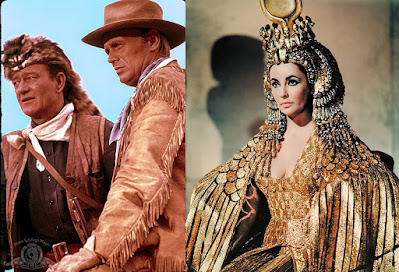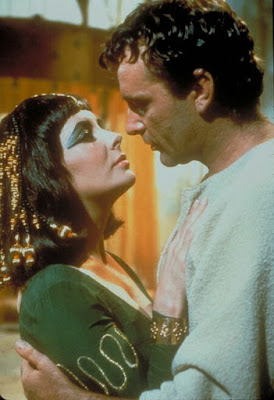 |
| Publicity photos from The Alamo (left) and Cleopatra (right), two films long considered failures that were actually profitable. |
The Alamo (1960)
 |
| Wayne directing on the set of The Alamo (1963) |
Starting in 1945, Hollywood star John Wayne had dreamed of directing a major production about the Battle of the Alamo. Over time, it had become something of an obsession for him. Realizing this dream would prove difficult, however: When he presented the idea to his home studio, Republic Pictures, they balked at the proposed $3 million production cost. Republic, which was known primarily for producing B-movie westerns, flatly refused to take the risk.
Frustrated, Wayne decided to finance the film himself, including taking out mortgages on his two houses and securing loans against his cars and yacht in the process, a major personal financial risk. However, before filming even started, Wayne's decision to self-finance the picture forced an artistic concession.
Originally, Wayne had intended to play the smaller part of Sam Houston, so that he could spend most of his time directing rather than acting. However, Wayne's creditors refused to back the production unless Wayne himself appeared in a lead role, believing that was the best way to ensure the film's success. Desperate to get the picture made, Wayne acquiesced and assumed the role of Davy Crockett.
 |
| The exterior façade of the Alamo replica. The entire set was painstakingly recreated using over 1.25 million hand-crafted adobe bricks. |
The production's biggest expense was the set. Wayne insisted on authenticity, and ordered an exact replica of the Alamo (and neighboring village) be constructed from scratch. The project was massive, and took two years to complete. When finished, the set included 14 miles of new roads, 6 new wells to provide water for the horses, miles of water and sewage lines, and 5,000 acres of horse corrals.
The principal photography also proved problematic. Issues with the weather and wildlife annoyed the cast and crew, and filming eventually took a total of 83 days, about 3 weeks longer than planned. By then, the film's $3 million budget had ballooned to an estimated $12 million. Wayne himself was under so much pressure (both financially and professionally) that he nervously smoked cigarettes non-stop whenever he wasn't on-camera.
When The Alamo was finally released in October 1963, it earned a box office take of $7.9 million, good enough to make it the 5th-highest earning production of the year, but well short of turning a profit.
It's for this shortcoming that The Alamo is most often remembered as a failure, a distinction that always offended Wayne. When asked about the film, he was always quick to (quite correctly) point out that The Alamo was a box office hit, just not a profitable one.
Ironically, The Alamo's savior would not be the silver screen at all, but rather the small screen. Since the 1940s, film productions had been finding new life (and revenue) by being sold to TV networks for broadcast. For the movie studios, this was a great way to increase a production's lifespan and squeeze some additional revenue from it before relegating it to the archives. The Alamo followed this trend when its television rights were sold to NBC in 1971. With this deal, The Alamo finally become profitable.
As of today, the final tally for The Alamo stands at $20 million of revenue against a $12 million budget, for a profit of $8 million. Not bad for a "failure".
Cleopatra (1963)
 |
| Taylor and Burton's real-life affair added intrigue to the film, but also helped scuttle Mankiewicz's plan to release the film as two features. |
In 1958, 20th Century Fox was interested in producing a film about Cleopatra. Two earlier films about the Egyptian ruler, one in 1917 and another in 1934, had performed well at the box office. Originally planned with a modest budget of $2 million in mind, producer Walter Wagner successfully negotiated a larger budget of $5 million in 1959.
Director Robert Mamoulian was hired to make the picture a reality, and star Elizabeth Taylor, one of Hollywood's biggest names at the time, was awarded an unprecedented $1 million contract to appear in the eponymous role, her fee representing approximately 20% of the film's budget at the onset of the production (Taylor had asked for a $1 million salary to appear in the film as an offhand comment when she was initially approached by Wagner. She was as shocked as anyone when the studio agreed).
From the beginning, the production was plagued with mismanagement, illness, and creative clashes. 16 weeks into the production, Mamoulian had burned through the film's entire planned budget of $5 million, plus an additional $2 million, yet had only approximately 10 minutes of usable footage to show for it. He was promptly fired by 20th Century Fox, and Joseph Mankiewicz was brought in to complete the film.
Matters got worse in January 1961 when Taylor fell ill with pneumonia and production had to be halted; her illness was serious enough that there was a legitimate risk that she may not recover. Quietly, 20th Century Fox began making arrangements for Audrey Hepburn to take over should the worst come to pass. Fortunately, Taylor made a full recovery, albeit a slow one that delayed filming for months.
 |
| So many wooden ships were built to film the climactic Battle of Actium scene that it was said 20th Century Fox had the world's 3rd largest navy. |
After taking over as director, one of the first decisions that Mankiewicz made was to move the production from England to Italy, requiring all of the elaborate (and expensive) sets to be constructed a second time. By the time filming resumed, daily production costs were exceeding $70k. Expansive scenes such as Cleopatra's grand parade into Rome and the naval Battle of Actium drained studio accounts, necessitating an "all hands on deck" effort by 20th Century Fox. All other studio productions were paused while all available resources were reallocated into Cleopatra to get it across the finish line.
With almost 6 hours of footage on hand at the end of filming, Mankiewicz intended to split Cleopatra into two separate features, called Caesar and Cleopatra and Antony and Cleopatra. However, 20th Century Fox objected to this plan, as star Richard Burton, whose adulterous affair with Taylor was now making tabloid headlines worldwide, would not appear in the first installment. Fearing that without Burton the first movie would be a flop (the thought being that the publicity surrounding the Burton-Taylor affair would help ticket sales), the studio ordered Mankiewicz to edit the footage into a single feature. This decision necessitated extensive re-shoots to get the film down to an appropriate length, further exacerbating the film's financial issues.
By the time Cleopatra was released in theaters in June 1963, the total cost of the production stood at a staggering $44 million (approximately $370 million today). While the film was the top earning release of 1963, its $40 million take at the box office was not enough to cover its costs. Like The Alamo, this is the reason that Cleopatra is often remembered as a failure.
Once again, it would be small screen that would save the biggest Hollywood production up to that time. In 1966, 20th Century Fox sold the television rights to Cleopatra to ABC for $5 million (then a record amount for a single film), allowing the studio to finally recoup its investment.
Delayed Gratification
Do either of these films deserve to be remembered as failures? Personally, I don't think so. Profitability isn't the only measure of a film's success (even though these two troubled productions were profitable in the end). People today (and generations to come) aren't going to judge these films by how profitable they were, but rather by how good they are. Both The Alamo and Cleopatra were received well by audiences, and that should be the lasting legacy of these films, as they'll continue to be seen and enjoyed by movie fans (like myself) long after the books have been closed.